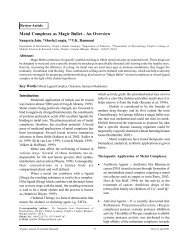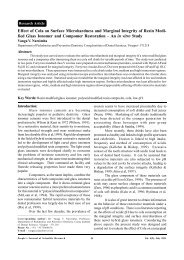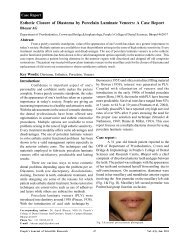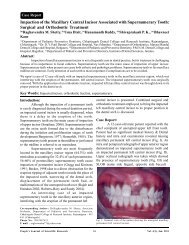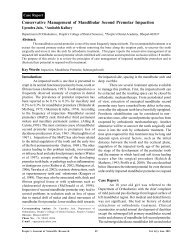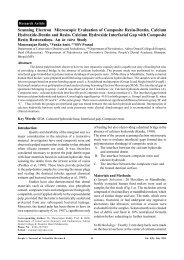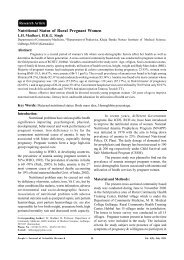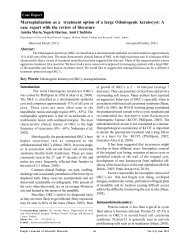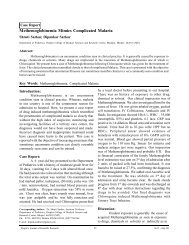Giant Cell Lesion of the Jaw - People's Journal Of Scientific Research
Giant Cell Lesion of the Jaw - People's Journal Of Scientific Research
Giant Cell Lesion of the Jaw - People's Journal Of Scientific Research
You also want an ePaper? Increase the reach of your titles
YUMPU automatically turns print PDFs into web optimized ePapers that Google loves.
<strong>Giant</strong> <strong>Cell</strong> <strong>Lesion</strong> <strong>of</strong> <strong>the</strong> <strong>Jaw</strong>: A Case Report in a Child -------------------------- Gupta M.K., Naidu S.G. & Maheshwari V.Jmore frequently in <strong>the</strong> mandible than in <strong>the</strong> maxilla in<strong>the</strong> anterior region <strong>of</strong> <strong>the</strong> jaws (Regezzi & Scuibba,1989). Radiographically, CGCG presents as radiolucentdefect, which may be unilocular or multilocular. Thedefect usually is well-circumscribed and, in some cases,displacement <strong>of</strong> teeth can be found (Chuong et al,1986). Central giant cell granuloma is expansive in itsgrowth; it does not grow around or invade nerve trunks.It also does not invade perineural sheaths or spreadvia perineural spaces. Histologically, CGCG containfocal arrangements <strong>of</strong> giant cells within a vascularstroma with thin-walled capillaries adjacent to <strong>the</strong> giantcells. There is a spindle cell stroma which may well be<strong>the</strong> cell <strong>of</strong> origin. The absence <strong>of</strong> perivascular cuffing(as seen in our case) can help differentiate CGCG fromcherubism (Pogrel, 2004). Presence <strong>of</strong> foreign bodytype giant cell (as seen in our case and absence <strong>of</strong>stromal tumour cells differentiate CGCG from a GCT.‘Solid‘aneurysmal bone cysts (ABC) are true benignneoplasms containing giant cells while trauma causingintramedullary hemorrhage has been implicated in <strong>the</strong>past as <strong>the</strong> etiology. Normal serum calcium, parathyroidhormone, alkaline phosphatase and phosphorous levelsdistinguish CGCG from o<strong>the</strong>r conditions like Browntumour <strong>of</strong> hyperparathyroidism (Pogrel, 2004).Cherubism is a self limiting condition, but giantcell granulomas can be aggressive with a tendency torecur and hence require treatment (Chuong et al, 1986).These lesions should be defined as “aggressive giantcell granulomas” <strong>of</strong> <strong>the</strong> jaws, ra<strong>the</strong>r than giant celltumor (Ficarra et al, 1987). <strong>Giant</strong> cell tumour, on <strong>the</strong>o<strong>the</strong>r hand is aggressive with a high recurrence ratebut also has a potential for malignant transformation(Hutter et al 1962). Aggressive/ recurring CGCG havea higher number and relative size index <strong>of</strong> giant cellsand a greater fractional surface area occupied by giantcells (Chuong et al, 1986).The conservative surgical treatment <strong>of</strong> CGCGusually involves curettage alone or alongwith peripheralostectomy with no evidence <strong>of</strong> disease in a 2 yearfollow up perior (Eisenbud et al, 1988). The margins <strong>of</strong><strong>the</strong> CGCG may also be <strong>the</strong>rmally sterilized with a laseror cryoprobes (Kermer et al, 1994). Radical surgicaltechniques <strong>of</strong> resection without continuity defect andperipheral ostectomy (Bataineh et al, 2002) and enblocresection have sometimes been justified for aggressiveCGCG (Chuong et al, 1986). However, recurrence withserious facial mutilation, loss <strong>of</strong> teeth and tooth germsseem unavoidable.Paediatric patients necessitate conservativemanagement to prevent long term developmentaldefects. Steroids and calcitonin have been advocatedin <strong>the</strong> recent past and <strong>the</strong>y at by inhibition <strong>of</strong> osteoclasticactivity. Equal parts <strong>of</strong> triamcinolone acetonide (10mg/ml) and 0.5% bupivacaine injected into <strong>the</strong> lesion for aperiod <strong>of</strong> 11 weeks has been shown to be effective ina child patient (Wendt et al, 2009). Relativecontraindications do exist in certain medical conditions,such as diabetes mellitus, peptic ulcer,and generalizedimmunocompromised states. Calcitonin nasal spray 200U/spray once or twice daily was reported to be safeand effective for <strong>the</strong> treatment <strong>of</strong> CGCG (Allon et al,2009). But, <strong>the</strong>rapy may be complicated owing to <strong>the</strong>great amount <strong>of</strong> discomfort and <strong>the</strong> relatively longduration <strong>of</strong> treatment, with poor compliance by children.Where surgery has been conservative dailysubcutaneous interferon alpha (3 million units/m 2 <strong>of</strong>body surface area) has been tried as an adjuvant dueto its anti-angiogenic properties; but significant sideeffects may limit its utility (Kaban et al, 2007). Acombination <strong>of</strong> interferon alpha and imatinib given for9 months has been shown to initiate regression <strong>of</strong> <strong>the</strong>lesion that continued after treatment had ceased (deLange et al, 2009). Bisphosphonates have also beenattempted intravenously with promising results (Daviset al, 1991). Never<strong>the</strong>less, recurrences <strong>of</strong> CGCG arenot uncommon and can be seen in upto 46% <strong>of</strong> cases(Whitaker et al, 1993).Conclusion:<strong>Giant</strong> cell lesions occur frequently in children<strong>of</strong>ten showing aggressive behaviour. Our approach toconservatively manage <strong>the</strong> lesion has shown goodresults with regular follow up till date. In conclusion,giant cell lesions may present as a diverse group <strong>of</strong>conditions peculiar to <strong>the</strong> jaw bones but, <strong>the</strong>ir diagnosisand management in <strong>the</strong> pediatric patient still remains achallenge to <strong>the</strong> clinician.Bibliography:1. Allon DM, Anavi Y, Calderon S, Central giant cell lesion<strong>of</strong> <strong>the</strong> jaw: nonsurgical treatment with calcitonin nasalspray. Oral Surgery, Oral Medicine, Oral PathologyOral Radiology & Endodontics, 2009 ;107(6):811-818.2. Bataineh AB, Al-Khateeb T, Rawashdeh MA. Thesurgical treatment <strong>of</strong> central giant cell granuloma <strong>of</strong> <strong>the</strong>mandible. <strong>Journal</strong> <strong>of</strong> Oral Maxill<strong>of</strong>acial Surgery , 2002;60(7): 756-776.People’s <strong>Journal</strong> <strong>of</strong> <strong>Scientific</strong> <strong>Research</strong> 66Vol. 4(1), Jan. 2011




